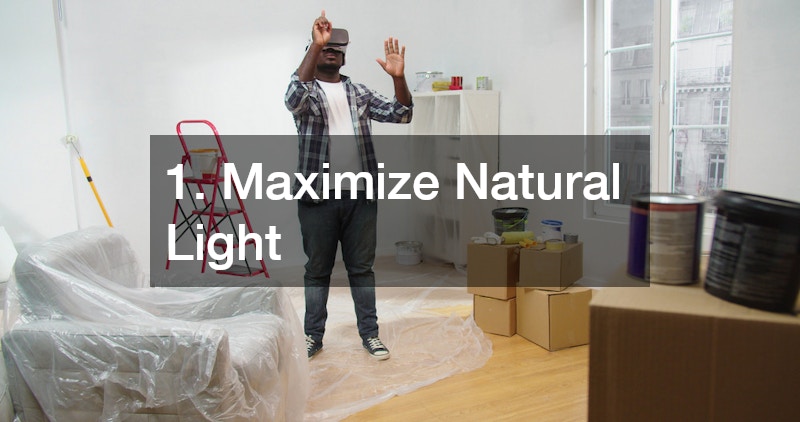Living in a small home or apartment can feel cozy, but limited space often creates challenges in comfort, storage, and functionality. Smart remodeling can dramatically improve how open and airy a space feels without expanding the actual square footage. By using thoughtful design strategies, strategic lighting, and clever material choices, homeowners can maximize usable space while enhancing aesthetics.
Remodeling small spaces requires careful planning to balance functionality, style, and storage. Simple improvements such as adjusting layout, selecting light-reflecting finishes, or integrating multifunctional furniture can make rooms feel larger and more inviting. These adjustments not only improve daily living but also increase the overall value of the property.
This guide highlights ten practical remodeling tricks to make small spaces appear more spacious. Each trick incorporates design principles, professional services, and material choices that work together to optimize comfort, efficiency, and visual appeal. Following these approaches helps homeowners transform compact areas into bright, open, and highly functional spaces.
1. Maximize Natural Light
One of the most effective ways to make a small space feel larger is to enhance natural light. Strategic placement and sizing of windows allow sunlight to fill the room, visually expanding the area. Collaborating with a windows and doors company ensures that window installation or upgrades are energy-efficient and aesthetically compatible with your home.
Removing heavy drapery and choosing light-colored window treatments can further amplify natural light. Skylights or additional windows in upper walls are also options to brighten interiors without compromising privacy. Reflective surfaces like mirrors opposite windows can bounce light around the room, enhancing the sense of openness.
Proper lighting planning reduces the reliance on artificial light and creates a more inviting environment. By investing in professional consultation from a windows and doors company, homeowners can choose the right size, style, and placement of windows to maximize daylight, improve energy efficiency, and make compact spaces feel airy and expansive.
2. Use Multifunctional Furniture
Smart furniture choices can dramatically transform the feel of small rooms, making them appear larger, more organized, and highly functional. Living room furniture that serves multiple purposes—such as ottomans with hidden storage, sofas with pull-out beds, or coffee tables with built-in compartments—helps homeowners maximize utility without crowding the floor. These pieces allow for discreet storage of blankets, toys, or other items, keeping rooms tidy while freeing up visual and physical space. Multi-purpose furniture ensures that small rooms remain practical for everyday use, entertaining, and occasional overnight guests.
In addition to dual-purpose pieces, floating shelves, wall-mounted desks, and fold-down tables provide valuable storage or work surfaces without permanently occupying floor space. Modular furniture arrangements offer flexibility, enabling homeowners to reconfigure seating, storage, or work areas depending on their needs. For example, stackable chairs or modular sectional sofas can adapt to social gatherings, work-from-home setups, or quiet relaxation, making small interiors feel versatile and expansive. Selecting lightweight materials, slimline designs, and neutral or light colors further ensures that furniture doesn’t dominate the room visually, helping maintain an airy, open atmosphere.
Incorporating multifunctional and adaptable pieces allows homeowners to maximize every inch of space without sacrificing comfort, style, or functionality. Careful planning of furniture placement, combined with smart storage solutions, creates an organized layout that feels spacious and uncluttered. By focusing on flexibility, proportion, and visual lightness, small rooms can serve multiple purposes seamlessly, offering comfort and practicality while maintaining a sense of openness. Thoughtful furniture choices ultimately allow homeowners to enjoy a functional, stylish, and visually expansive living environment, even within limited square footage.
3. Utilize Open-Concept Layouts

Removing non-structural walls and creating open-concept layouts is a proven method to make small spaces feel more expansive. This approach connects rooms, improves traffic flow, and maximizes usable square footage. Professional house remodeling services can ensure that structural integrity is maintained while walls are removed or reconfigured.
Open layouts also enhance natural light distribution, allowing sunlight to penetrate further into interior spaces. Combining living areas with kitchens or dining spaces creates multifunctional zones, ideal for entertaining or family interaction. Integrating consistent flooring across areas visually unifies rooms, further enhancing the sense of space.
Careful planning of open-concept remodeling ensures that small homes feel larger and more connected while maintaining functional zones. Collaborating with experienced house remodeling professionals helps homeowners safely execute structural changes that maximize openness without sacrificing safety or design cohesion.
4. Upgrade Flooring to Reflect Light
Flooring choices play a critical role in how spacious a room feels, influencing both the visual flow and overall ambiance of small interiors. Luxury vinyl tile flooring in lighter tones, soft wood finishes, or neutral shades can create a sense of openness by reflecting light and maintaining visual continuity throughout connected spaces. Selecting materials with minimal patterns or subtle textures prevents visual clutter, helping small rooms feel clean, cohesive, and streamlined. Even minor decisions, like the direction of the planks or tile layout, can significantly impact how expansive a room appears.
Seamless flooring across multiple rooms enhances the sense of flow, creating an illusion of extended space and unifying areas that might otherwise feel compartmentalized. Vertical plank arrangements or subtle diagonal layouts can draw the eye outward, making floors appear larger while adding visual interest. For rooms that experience heavy use, such as kitchens, hallways, or living areas, luxury vinyl tile flooring provides the added benefits of durability, stain resistance, and easy maintenance without sacrificing style. These qualities make it an ideal choice for compact, high-traffic spaces where both function and aesthetics matter.
Professional installation ensures that flooring is precisely laid, minimizing gaps, misalignments, or uneven surfaces that could detract from the overall effect. When paired with thoughtful color selection, coordinated trims, and strategic lighting, flooring upgrades become a highly effective, cost-efficient method for visually enlarging small rooms. Beyond the immediate aesthetic impact, quality flooring adds long-term value, durability, and ease of care, making it a smart investment for homeowners who want their small interiors to feel open, inviting, and well-designed.
5. Optimize Kitchen Storage and Layout

Small kitchens benefit greatly from strategic kitchen remodeling contractors who can redesign layouts for efficiency and visual openness. Installing tall cabinets, pull-out shelves, and corner storage solutions maximizes capacity without crowding the space.
Choosing light-colored cabinetry or reflective finishes makes walls recede visually, contributing to a larger feel. Removing upper cabinet bulk or integrating open shelving can further enhance openness while keeping storage functional. Appliances should be appropriately sized to maintain proportion and prevent the area from feeling cramped.
A well-planned kitchen remodel increases both storage and workspace while maintaining a light, airy atmosphere. Professional kitchen remodeling contractors ensure that modifications optimize workflow, storage, and aesthetics, transforming even a compact kitchen into a spacious, functional heart of the home.
6. Incorporate Mirrors and Reflective Surfaces
Mirrors and reflective surfaces amplify light and create the perception of depth, making rooms feel larger. Strategically placing mirrors opposite windows or in narrow corridors bounces natural light and enhances visual space. Glass and polished finishes on furniture, backsplashes, or decor similarly contribute to openness.
Granite countertops with a polished finish not only provide durable work surfaces but also reflect light, brightening kitchens and bathrooms. Light-colored tiles, glossy cabinetry, and glass fixtures can all serve to expand the perceived space.
By integrating reflective materials thoughtfully, homeowners can make small interiors appear airy and open without significant structural changes. These design choices complement practical remodeling efforts, ensuring that every element contributes to a sense of spaciousness.
7. Expand Outdoor Connections

Small homes often feel confined if outdoor areas are underutilized. Installing landscape lighting installations and expanding patios or decks visually extends living spaces. Proper lighting draws attention to yards or gardens, creating a sense of depth beyond interior walls.
Sliding glass doors, French doors, or large windows provide seamless connections between indoors and outdoors, allowing natural light and views to extend perceived space. By integrating landscape lighting installations, homeowners can enjoy usable outdoor areas in the evening while enhancing ambiance and security.
Creating strong visual and functional connections between indoor and outdoor areas makes compact homes feel larger and more versatile. Thoughtful outdoor enhancements complement interior remodeling, improving both aesthetics and livable space.
8. Streamline Interior Elements
Minimalism and organization are essential for making small spaces feel larger and more inviting. Avoid overcrowding rooms with oversized furniture, bulky décor, or excessive storage items that can quickly create a cramped and chaotic environment. Keeping pathways clear, arranging furniture thoughtfully, and using uniform color palettes across walls, floors, and furnishings help create visual cohesion and an uninterrupted flow, enhancing the perception of space.
Incorporating smart storage solutions in kitchens, living rooms, and bedrooms is key to reducing clutter while maintaining functionality. Built-in shelving, under-bed drawers, multi-purpose furniture, and vertical storage options maximize every available inch without encroaching on floor space. Performing seasonal inspections of cabinets, drawers, closets, and storage areas allows homeowners to identify and remove unnecessary or unused items, freeing up valuable space and improving organization.
Be sure to address any necessary electrical repairs during these inspections. Ensuring outlets, switches, and lighting systems function properly not only maintains safety but also supports practical organization and room layout. Well-placed lighting and accessible outlets make it easier to utilize vertical storage, multifunctional furniture, and workspace areas efficiently, further enhancing the sense of openness.
This approach promotes a sense of openness, order, and calm in small interiors. Combining design simplicity with practical storage solutions ensures that each room remains functional and aesthetically pleasing. Even compact spaces can feel airy, comfortable, and well-organized when every item has a designated place.
9. Update Windows and Glass Features
Replacing or enlarging windows improves natural light and enhances the sense of space. Working with a windows and doors company ensures proper installation and energy efficiency. Adding skylights or glass panels in strategic areas brings sunlight deeper into interiors.
Glass replacement in doors, partitions, or decorative features contributes to openness and allows light to flow between rooms. Frosted or textured glass maintains privacy while still letting light pass through.
By incorporating professional windows and doors company services and glass replacement, homeowners can significantly expand the perceived size of small rooms. These improvements enhance comfort, functionality, and energy efficiency while brightening compact living spaces.
10. Upgrade Key Surfaces and Finishes
Finally, refreshing key surfaces such as granite countertops, cabinetry, and flooring is one of the most effective ways to enhance both functionality and the perception of space in small homes. Selecting lighter finishes, polished textures, or reflective materials helps to increase brightness, making rooms feel more open and airy. Coordinated finishes across multiple surfaces create visual continuity, reducing the sense of fragmentation and contributing to a seamless, spacious look. Even subtle changes, such as swapping dark countertops for lighter ones or updating cabinet hardware, can dramatically influence how expansive a room feels.
Regular attention to surfaces also improves durability and simplifies maintenance, which is essential in small spaces where every inch counts. Upgrading countertops or cabinetry can introduce smarter storage solutions, cleaner lines, and integrated organizational features, allowing homeowners to maximize usable space while maintaining a tidy appearance. For example, built-in shelving, pull-out drawers, or corner storage solutions optimize functionality without crowding the room. Flooring updates, such as light-colored luxury vinyl tile flooring or coordinated materials, further enhance the perception of openness while providing a durable, easy-to-clean foundation for daily life.
Attention to finishing details—whether it’s matching tones across cabinetry and countertops, ensuring smooth transitions between flooring types, or incorporating reflective backsplashes and polished surfaces—transforms small spaces from cramped and cluttered to cohesive, stylish, and highly functional. By combining aesthetics with practical upgrades, homeowners can create rooms that feel larger, more organized, and more enjoyable to live in.
Small spaces don’t have to feel cramped or limiting. With carefully planned remodeling strategies, clever design techniques, and the support of professional services, homeowners can significantly maximize usable square footage while creating interiors that feel open, airy, and inviting. Every detail plays a critical role in shaping the perception of space.
By combining professional remodeling expertise with intentional design choices, homeowners can transform small spaces into bright, functional, and highly appealing areas. Seasonal updates, organized layouts, and the use of reflective materials such as glass, polished surfaces, or light-colored finishes further reinforce a sense of openness. Over time, these strategies not only make interiors feel larger but also improve energy efficiency, comfort, and overall home value.



